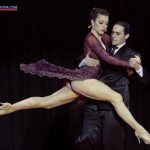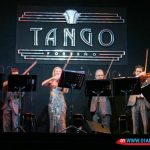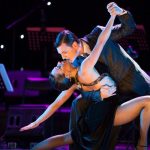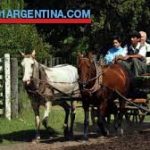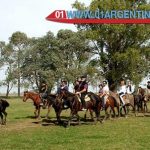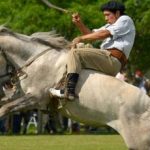
Two shows representative of Argentina.
Tango Show
Enjoy the most representative music of Argentina. Dinner – Show in the most distinguished houses of tango in Buenos Aires.
The splendor of Complejo Tango show deserves a separate chapter. Under the guidance of a renowned orchestra, a cast of professional dancers and worthy of the capital of tango singers looks.
The show traces the history of tango from its beginnings in five memorable scenes.
Undoubtedly the finishing touch to an unforgettable dinner.
Designed to meet international gourmet menu includes typical, musts for those visiting Buenos Aires dishes. The excellence of the Argentine wine has a special place in our dinner.
Among the various activities offered Complejo Tango Academy acclimated rooms where oak floors look stands out.
Here, Tango enthusiasts can have private and group lessons with top-notch faculty. Either to improve or to learn the secrets of dancing, singing and music in the very cradle of the milonga.
Esquina Carlos Gardel
Located in the neighborhood of Abasto, has a sextet, more than 20 artists on stage, the only impersonator Carlos Gardel and the unique Tango dancer Carlos Copelo. The place is luxurious and it is said that was the first place where Carlos Gardel sang (formerly called El Chanta Cuatro).
The food is very good with a menu of over 30 options (some more if you choose the Executive or VIP option) and San Felipe wine or Ruttini (depending on the option). open bar of drinks. Wine, beer, soft drinks, etc.
Señor Tango
Located in the neighborhood of Barracas, it is the largest tanguería of Buenos Aires (1500 people). His show is kind Moulin Rouge with a great display of special effects artists and what a great visual appeal. Towards the end, the presence of Ernesto Franco (who was bandoneon player of D’Arienzo) enhances the show with an orchestra that recalls the music of D’Arienzo; one of the best rhythm orchestras in the Golden Age of Tango.
The food is good and open bar drinks. Wine, beer, soft drinks, etc.
Tango Porteño
Located on Avenida 9 de Julio, in the heart of downtown and a few meters from the Obelisk; symbol of this city. Here you can enjoy a tango class before the show, where he will contact professional Tango Dancers.
The show revives the golden age of Tango. It features 30 artists on stage, an orchestra of 12 musicians, 8 couples of professional dancers and 2 singers. The Golden Decade shines again in this unique and modern show that recovers the traditional essence of Tango.
Also enjoy a varied cuisine and taste of our Argentine meat among other options.
Piazzolla Tango
Located in the heart of downtown, it has a very picturesque place, a theater French style carefully restored, a luxurious lounge and perfect acoustics that will make your visit an unforgettable evening. His show is based on the “Stations Porteñas” Astor Piazzolla at different moments of his life. His orchestra of 6 musicians is accompanied by four dancing couples and 2 singers: Marili Machado and Ricardo Marin. In addition to a very good tango show, you can enjoy fine cuisine. Variety of appetizers, main courses and desserts.
Drinks included: varietal wines from Bodegas Graffigna, gas and mineral water.
Complejo Tango
Located in the heart of Barrio de Balvanera, it has a warm and comfortable atmosphere with capacity for 100 people. It offers a different option for Tango lover. Here you can enjoy a tango class before the show, where he will contact professional Tango Dancers. It has an entertaining show walking step by step the history of tango and a varied dining option.
Drinks included: Wine or Champagne, mineral water or soft.
Taconeando
It is located in the neighborhood of San Telmo, tango neighborhood par excellence. The place has a capacity for 120 people and an excellent distribution of its tables. Founded in the 80’s by Beba Bidart, an actress and singer of tango and declared of tourist interest by the Government of the City of Buenos Aires. It has a 4 orchestra musicians, dance 7 couples and 3 singers; including Daniel Olivera. The atmosphere and special attention will provide an excellent option to enjoy one of the most traditional shows of Buenos Aires.
Gastronomy: variety appetizers, main courses and desserts. Beverages: Mineral water, soft drinks and coffee. Wine with VIP option.
Gaucho Party in Buenos Aires
Prepare to discover the tradition of Argentine gaucho Gaucho in these amazing shows in Buenos Aires. Discover our history, culture and traditions. A unique opportunity where you can see more than 10 dancers and riders and enjoy during the show, the best Argentina meat.
Full day excursion. Visit a. Here you can enjoy hayrides and horses, a Creole barbecue, music show, folk dances and gaucho skill, racing ring and cuadrera, museum and various activities offered stay.
The gauchos will welcome you with fried meat pies and baked vegetables accompanied with a good wine, water and / or gas.
Roots of tango and the gaucho in Argentina
The typical dance of the gauchos
Chacarera is dancing original dance floklórica Argentina, specifically in the province of Santiago del Estero, though, today, is have spread throughout Argentina and even a part of Bolivia (Chaco region). This dance has its own music, which is played with guitar, bass and violin, but from the twentieth century have been added various instrumental ensembles.
This dance is performed as a couple in a group of several couples and has a free pace, but must maintain coordination with the other couples in the group. However, the basic steps of this dance consist of rounds and turns.
Woman costume consists of a long black panties skirt usually dark color or tone. The top consists of a gray or white turtleneck shirt, on which feature a sort of jacket of this suit is placed. Finally, women hair a comb is placed.
As for the man, he also takes a bloomers, ie, wide and tight in the waist part of pants. At the top, wearing a white shirt with buttons on her jacket. Never missing hat, usually go to match the color of the jacket.
The most representative of Argentine folklore gaucho suit is both its male and female version. The use of the term gaucho dates back to colonial times and there are several theories.
On the one hand, it is thought to come from the word huachu Quechua language, which means orphan, vagabond and was transformed into the term used today because of the pronunciation that gave the Spaniards.
Another theory is that the word associated with the word chaouch of Arab origin and meaning arreador animals.
In either case, it means a type of cowboy gaucho semi-nomadic nature of the plains and areas near Argentina and parts of Uruguay, Paraguay, Bolivia’s Chaco and southern Brazil.
The figure of the gaucho emerged in Argentina back in 1600, after the Spanish take the horse to the New World. Originally, he was a loner and free spirit with few possessions beyond his horse.
Today, the gaucho still occupies a very important place in Argentine folklore, especially in agriculture, whose men still wear this outfit.
The classic male Argentine gaucho costume combines a fully black pants with a white shirt and, above it, a short-sleeved jacket open. These garments form the basis of this outfit, which includes a number of accessories that will be key to really consider the gaucho costume.
Undoubtedly the star accessory is a red scarf tied with a knot frontally, ie neck. Other important details are a brown belt and boots, which always go over trousers. Finally, this suit also includes a kind of beret characteristic reddish color.
Tango
The tango is at the same time, a musical genre and type of original dance especially popular in Argentina and the Rio de la Plata and Buenos Aires and Montevideo (Uruguay). The tango dates back to the late nineteenth century as a result of a merger between River Plate culture, African, Italian, Hispanic and Indian.
The tango is a sensual dance that is danced in pairs and, therefore, the traditional costume used for this dance is equally sensual. It highlights the feminine attire, usually consisting of a red dress, but can also be black, with a side opening on one side, so that one leg is semi-naked.
Although it is usually a short dress, there is also a longer version. Under the dress, they are often carried half transparent, semi-transparent grid of black or color. Shoes are always heels.
As for the menswear tango, it always involves a suit, which can be totally black or black with thin white stripes. Under the suit, he is wearing a white shirt tanguero, above which may include a tie or bow tie optional, and never lack the black hat. The bottom line is that the male attire conveys a stylish image and at the same time, manly.

